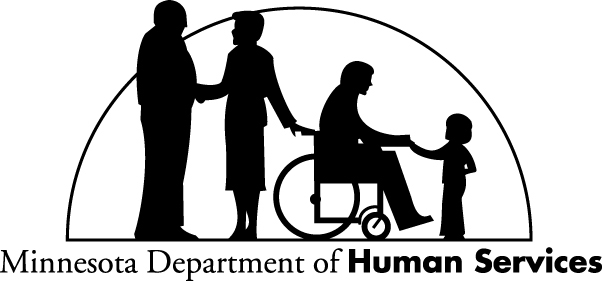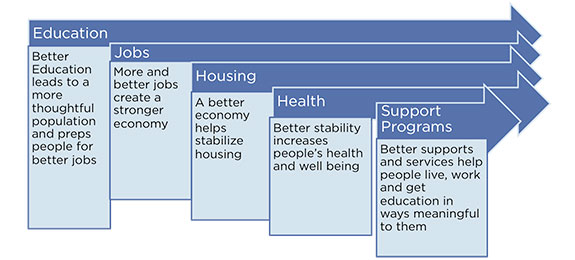Introduction to the Jensen Settlement Agreement
Introduction to the Jensen Settlement Agreement

Overview of Training
This training will answer questions about the Jensen Settlement Agreement. When you are finished with this training, you should be able to:
- Describe the Jensen lawsuit and settlement agreement.
- Describe the Comprehensive Plan of Action.
- Understand the impact of the Jensen Settlement Agreement on you or your loved one.
The Lawsuit & Settlement
Jensen et al. vs. State of Minnesota et al.
The Lawsuit
In July of 2009, the families of three individuals being served in the Minnesota Extended Treatment Options (METO) program filed a lawsuit against DHS. This lawsuit was expanded to include all individuals being served at METO between July 1, 1997 through May 1, 2011 as a single class, meaning the decision of the court would apply to all of them.
The lawsuit alleged that the METO program used restraint and seclusion in a way that broke the law and violated the rights of the individuals.
Jensen v. Minnesota Department of Human Services Lawsuit.The Jensen Settlement Agreement
Rather than a trial, both the people who brought the lawsuit and the State of Minnesota agreed to settle the case.
In December of 2011 the court approved the Jensen Settlement Agreement with the understanding that the court would oversee the agreement to make sure all parties did what they said they would.
In 2012, Federal District Court Judge Donovan Frank appointed David Ferleger, Esq., as the court monitor to make sure the agreement is being followed.
Settlement Details – DHS Programs
The Jensen Settlement Agreement results in major changes to the way DHS treats people in its programs. DHS agreed:
- To stop using mechanical restraints on people with developmental disabilities. Mechanical restraints are devices that restrict free movement of an individual and can include handcuffs, leg-irons, and other similar devices.
- To stop using manual restraints on class members except in an emergency.
- To stop using seclusion and chemical restraints on class members.
- To set a new course towards the implementation of best practices for persons with disabilities.
Settlement Details – DHS Programs (Continued)
The Jensen Settlement Agreement results in major changes to the way DHS treats people in its programs. DHS agreed:
- To serve people in the most-integrated setting: an environment that is consistent with the person’s goals, dreams and aspirations.
- To train its staff in person-centered thinking and planning as well as positive behavioral support and intervention.
Settlement Details – DHS & State Duties
As part of the Jensen Settlement Agreement:
- DHS has agreed to follow all court orders in the case.
- The state of Minnesota has agreed to make statewide changes and develop a plan for all people with disabilities, under Minnesota’s Olmstead Plan.
- DHS’ goal is to establish or create placement alternatives to support people in the most integrated setting of the person’s choice to meet the person’s individualized needs.
- DHS must report to the court regularly on their efforts to implement the details of the settlement agreement.
Implementing the Jensen Settlement Agreement
Comprehensive Plan of Action
Comprehensive Plan of Action (CPA)
On March 12, 2014, a Comprehensive Plan of Action (CPA) was adopted by the court.
The CPA outlines the path the department will take to come into compliance with the terms of the Settlement Agreement.
As part of the CPA, DHS agreed to establish the Jensen Implementation Office, which will be responsible for management of this plan.
CPA Parts
The CPA is broken up into three parts:
- Part I addresses the closure and replacement of the Minnesota Specialty Health System (MSHS)-Cambridge facility with community homes and services.
- Part II addresses the modernization of Rule 40 (positive support rule).
- Part III addresses the development of Minnesota’s Olmstead Plan.
CPA Part I - Close MSHS-Cambridge and Develop Community Services
DHS officially closed the METO program June 30, 2011 and replaced it with the Minnesota Specialty Health System (MSHS)-Cambridge.
DHS also agreed to close MSHS-Cambridge, which was closed August 30, 2014 and replaced with Minnesota Life Bridge Program
Minnesota Life Bridge Program
- Focuses on supporting people in their home and arranging for services to come to them.
- Provides short-term, community-based residential treatment for those who need it.
CPA Evaluation Criteria 98 - Class Members and the Therapeutic Follow-up Group
Class Member - All individuals who were subjected to the use of any aversive or deprivation procedures, including restraints or seclusion while a resident at the METO program at any time(s) from July 1, 1997 through May 1, 2011.
In addition to Class Members, individuals who received treatment at MSHS-Cambridge between July 1, 2011 until August 30, 2014 are all included in the Therapeutic Follow-up Group.
Some Class Member Entitlements Identified in the CPA
Current Person-Centered Plan
Positive Behavior Supports
Functional Behavior Assessment
Most Integrated Setting
Therapeutic Follow-up
CPA Part II – Modernization of Rule 40
Rule 40 governs the use of aversive and deprivation procedures in licensed facilities that serve persons with developmental disabilities.
The new rule
- Focuses on positive behavioral supports.
- Applies to home and community-based services licensed under Minnesota Statutes, Chapter 245D for:
- Persons with a disability or persons aged 65 or older and
- All department-licensed facilities and programs to persons with a developmental disability or related condition
Olmstead Plan
In 2013, Minnesota created an Olmstead Plan to improve how it serves people with disabilities. This was important because:
- 10% of Minnesotans have a disability, and this number is growing as the population ages.
- Many Minnesotans with disabilities have less access to choices and opportunities than those without disabilities.
- Resources to manage disabilities and support people in a way and place that is best for them are unavailable or unrealistic.
- Limits on a person with disabilities’ freedom creates a big problem for Minnesota.
A better Minnesota for all of us
Minnesota can’t fully thrive if people aren’t able to live in a place and a way that’s best for them. This is segregation.
Healthy, educated, employed, stable people are the heart of strong, respectful, thriving communities. When our community thrives, we all benefit.

- Education
- Better education leads to a more thoughtful population and preps people for better jobs.
- Jobs
- More and better jobs create a stronger economy.
- Housing
- A better economy helps stabilize housing.
- Health
- Better stability increases people's health and well being.
- Support Programs
- Better supports and services help people live, work and get education in ways meaningful to them.
The Olmstead Vision
The Olmstead Plan will help achieve a Better Minnesota for all Minnesotans, because it will help Minnesotans with disabilities have the opportunity, both now and in the future, to:
- Live close to their family and friends.
- Live more independently.
- Engage in productive employment.
- Participate in community life.
Minnesota’s Olmstead Plan - How do we get there?
The aim of Minnesota’s Olmstead Plan is to build communities that welcome, engage and respect people with disabilities at the highest level possible and more than ever before.
| Whole Person |
The Seven Domains
|
Accountable and Effective
Minnesota’s Olmstead Plan aspires us to make a difference for people in our communities. Simply working hard is not good enough. To be successful, we need to improve the options for Minnesotans with disabilities.
To do this we are beginning to measure in three areas:
- Movement from segregated to integrated opportunities.
- Getting rid of waiting lists for services, or making sure the lists keep moving.
- Overall quality of life for people with disabilities.
It’s the Law.
Improving people’s lives is the right thing to do. It’s also the law.
Our Olmstead Plan complies with:
- The Minnesota Human Rights Act (State law)
- The Americans with Disabilities Act (Federal law)
Both of these laws prohibit discrimination against people with disabilities.
The Olmstead Plan is named after a landmark civil rights case that reached the U.S. Supreme Court. The Court’s decision defined the rights of people with disabilities.
Minnesota’s legacy
The Olmstead Plan spells out a thorough approach to transform our system so people with disabilities can be fully integrated into their community.
Olmstead Information
When we meet the Plan’s goals, Minnesota will again set the highest standards for disability services in the nation. We will become a model for other states and communities to follow.
Most importantly, the Plan will improve the lives of all Minnesotans.
You can get more information and read Minnesota’s complete Olmstead Plan on the Olmstead Office’s website.
Charting a New Course
Practical Effects on Counties, Providers, & Individuals being served.
How does the Jensen Settlement Agreement and CPA affect the work of counties and providers?
DHS must use its best efforts to make sure lead agencies (Counties, Tribal Nations and Managed Care Health Plans) and providers are following the same best practices in their programs that have been adopted in DHS programs.
This may mean changes in rate setting or contracts, or changes in rules and statutes to require that counties and providers update their services.
How does the Jensen Settlement Agreement and CPA affect people receiving services from DHS?
As part of the Jensen Settlement Agreement DHS has agreed:
- Not to use mechanical or chemical restraints or seclusion on people with developmental disabilities.
- Not to use manual restraints on people with developmental disabilities except in an emergency to protect the person or people around them.
How does the Jensen Settlement Agreement and CPA affect people with disabilities?
As part of the Jensen Settlement Agreement, DHS has agreed:
- To make changes that set a new course towards the implementation of best practices for persons with disabilities.
- To serve people in the most-integrated setting, in an environment that is consistent with the person’s goals, dreams and aspirations.
Video Resources
Jensen Settlement Agreement Training Videos
These videos will help you get a fuller picture of the Jensen Settlement Agreement.
Video Resources
Jensen Settlement Agreement Training Videos
These videos will help you get a fuller picture of the Jensen Settlement Agreement.
Video Resources
Jensen Settlement Agreement Training Videos
These videos will help you get a fuller picture of the Jensen Settlement Agreement.